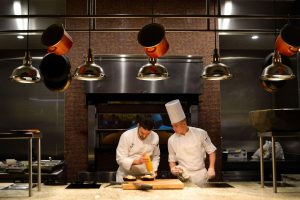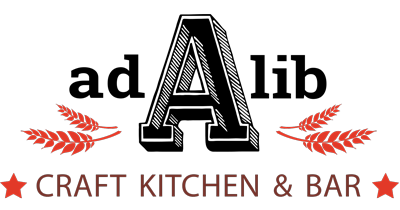The Making of a Menu—an Insider’s View
Chances are you’ve looked at quite a few menus in your life. Have you ever stopped to think about what goes into making that menu? We sat down with our chefs to get you the inside story – from conception to plate!
Insider Tips for Creating a Restaurant Menu

Step One: Keep It or Sweep It
When the time comes for a new menu, the first thing the Ad Lib chefs do is decide what is going to stay and what will be replaced. The process starts about two months before the new menu is introduced. This gives chefs plenty of time to consider the popularity and seasonality of each dish, as well as whether it will be able to work within both the Ad Lib and 1700 menus.
Step Two: Out with the Old, In with the New
Once the chefs decide which dishes are leaving, it’s time to think about what to replace them with. Typically, a fish dish is replaced by a different fish, beef replaces beef and so on.
Deciding what to bring in starts with our purveyors, who provide our meat and produce. They have a wealth of knowledge when it comes to what they sell, and the Ad Lib team takes full advantage of their input. The chefs look for unique ingredients that fit into Ad Lib’s point of view; think of our bison short ribs, which offer a little twist on a traditional short rib dish.
After getting an idea of what’s available from each purveyor, the chefs thoroughly research the products to learn more.
Step Three: Time to Cook
Now comes the real work – creating those fun, funky dishes that you know and love. Different chefs take different approaches to this process. Chef Anthony Bianco looks at his ingredients the way an artist views a palette. The plate is his canvas, and he begins by combining the five primary flavors; salty, sweet, sour, bitter, and umami. After he establishes a flavor profile, Chef Bianco finishes his compositions by finalizing the colors and textures of the dish.

Chefs Mike Rittel and John Fabian experiment with new flavors.
Chef Mike Rittel takes a more straight-forward approach. He thinks about where his main ingredient comes from and what else is utilized in that region. He also likes to start with something familiar and incorporate it in a new way. When asked if he keeps up on trends, Chef Rittel replied, “In the last few years, I’ve noticed that we’re ahead of the trends, and it wasn’t intentional.”
Step Four: Meet and Eat

The senior management team tastes new dishes.
Finally, the menu is developed. It’s time for the first tasting. The team comes together to prepare and test every new dish. The chefs taste everything alongside our General Manager, Food and Beverage Director and the Senior Restaurant Manager. Textures are tweaked, flavors fussed and plating is perfected before the menu is given the full stamp of approval.
Step Five: 3, 2, 1… Launch!

It’s New Menu Day. This is when the service staff is brought in to learn about and taste all the new items on the menu. It’s one of the most important steps of the process — the servers are the liaison between the chefs and the guests.
That night, the menu will be served at dinner, which means a fun challenge for the kitchen staff. “It’s interesting to see the guest and staff reactions,” Chef Bianco says. “We see why things are old favorites and can start to guess what might be the new big hit.”
Be sure to make a reservation to visit us soon and check out our new spring menu, our new cocktail menu and our updated happy hour!

